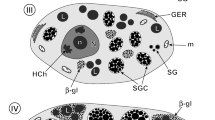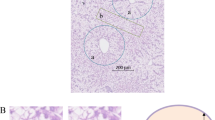Abstract
Liver tissue was sampled from flounder (Pleuronectes americanus) throughout the year with the intention of documenting changes in the ultrastructure coincident with the production and secretion of antifreeze proteins. In the winter, hepatocytes are dedicated to the production of these proteins and, in the female, also reproductive proteins. In both sexes, liver cells in the summer contain abundant lipid and glycogen stores. In the female, there is a conspicuous hepatocyte transformation from a fat-filled cell in the summer to one with well-developed rough endoplasmic reticulum in the winter. Large amounts of rough endoplasmic reticulum (11.2 mg/gm) were recovered after subcellular fractionation of female wintertime liver. The increased appearance of secretory organelles and the high number of nucleolar profiles observed in winter animals is consistent with the elevated demand for protein secretion and synthesis in both sexes. The fractional volumes occupied by lipid droplets and mitochondria were different when comparisons were made between sex and season. Females contained a greater volume of lipid than did males, and summer animals contained more lipid than those in winter.
Similar content being viewed by others
References
Baker JTP (1969) Histological and electron microscopical observations on copper poisoning in the winter flounder (Pseudopleuronectes americanus). J Fish Res Bd Canada 26:2785–2793
Bradford MM (1976) A rapid and sensitive method for the quantitation of microgram quantities of protein utilizing the principle of protein-dye binding. Anal Biochem 72:248–254
Bodammer JE, Murchelano RA (1990) Cytological study of vacuolated cells and other aberrant hepatocytes in winter flounder from Boston Harbor. Cancer Res 50:8744–8756
Campbell CM, Davies PS (1978) Temperature acclimation in the teleost, Blennius pholis: changes in enzyme activity and cell structure. Comp Biochem Physiol [B] 61:165–167
Campbell CM, Idler DR (1976) Hormonal control of vitellogenesis in hypophysectomized winter flounder (Pseudopleuronectes americanus Walbaum). Gen Comp Endocrinol 28:143–150
Davies PL, Hew CL (1990) Biochemistry of fish antifreeze proteins. FASEB 4:2460–2465
DeVries AL (1983) Antifreeze peptides and glycopeptides in cold-water fishes. Annu Rev Physiol 45:245–260
DeVries AL, Cheng C-HC (1992) The role of antifreeze glycopeptides and peptides in the survival of cold-water fishes. In: Somero GN, Osmond CB, Bolis CL (eds) Water and life. Springer, Berlin Heidelberg New York, pp 301–315
Duman JG, DeVries AL (1974) Freezing resistance in winter flounder Pseudopleuronectes americanus. Nature 247:237–238
Duman JG, DeVries AL (1976) Isolation, characteriztion, and physical properties of protein antifreezes from the winter flounder (Pseudopleuronectes americanus). Comp Biochem Physiol [B] 54:375–380
Fletcher GL, King MJ (1978) Seasonal dynamics of Cu2+, Zn2+, Ca2+, and Mg2+ on gonads and liver of winter flounder (Pseudopleuronectes americanus): evidence for summer storage of Zn2+ for winter gonad development in females. Can J Zool 56: 284–290
Fletcher GL, King MJ, Kiceniuk W, Addison RF (1982) Liver hypertrophy in winter fluonders following exposure to experimentally oiled sediments. Comp Biochem Physiol [C] 73:457–462
Fletcher GL, Haya K, King MJ, Reisman HM (1985) Annual antifreeze cycles in Newfoundland, New Brunswick and Long Island winter flounder, Pseudopleuronectes americanus. Mat Ecol Prog Ser 21:205–212
Fourney RM, Joshi SB, Kao MH, Hew CL (1984) Heterogeneity of antifreeze polypeptides from the Newfoundland winter flounder, Pseudopleuronectes americanus. Can J Zool 62:28–33
Hampton JA, McCuskey PA, McCuskey RS, Hinton DE (1985) Functional units in rainbow trout (Salmo gairdneri, Richardson) liver. I. Histochemical properties and arrangements of hepatocytes. Anat Rec 213:166–175
Hampton JA, Lantz RC, Goldblatt PJ, Lauren DJ, Hinton DE (1988) Functional units in rainbow trout (Salmo gairdneri, Richardson) liver. II. The biliary system. Anat Rec 221:619–634
Hampton JA, Lantz RC, Hinton DE (1989) Functional units in rainbow trout Salmo gairdneri, Richardson) liver. III. Morphometric analysis of parenchyma, stroma, and component cell types. Am J Anat 185:58–73
Hew CL, Fletcher GL (1985) Biochemical adaptations to the freezing environment—structure, biosynthesis and regulation of fish antifreeze polypeptides. In: Gilles R (ed) Circulation, respiration and metabolism. Springer, Berlin Heidelberg New York, pp 553–563
Köhler A (1989) Regeneration of contaminant-induced liver lesions in flounder—experimental studies towards the identification of cause-effect relationships. Aquat Toxicol 14:203–232
Lin Y (1979) Environmental regulation of gene expression — in vitro translation of winter flounder antifreeze messenger RNA. J Biol Chem 254:1422–1426
Lin Y, Long DJ (1980) Purification and characterization of winter flounder antifreeze peptide messenger ribonucleic acid. Biochem 19:1111–1116
Moore MJ, Smolowitz R, Stegeman JJ (1989) Cellular alterations preceding neoplasia in Pseudopleuronectes americanus from Boston Harbor. Marine Environ Res 28:425–429
Murchelano RA, Wolke RE (1991) Neoplasms and nonneoplastic liver lesions in winter flounder, Pseudopleuronectes americanus, from Boston Harbor, Massachusetts. Environ Health Persp 90:17–26
Ng TB, Woo NYS, Tam PPL, Au CYW (1984) Changes in metabolism and hepatic ultrastructure induced by estradiol and testosterone in immature female Epinephelus akaara (Teleostei, Serranidae). Cell Tissue Res 236:651–659
Olivereau M, Olivereau J (1979) Effect of estradiol-17β on the cytology of the liver, gonads and pituitary, and on plasma electrolytes in the female freshwater eel. Cell Tissue Res 199: 431–454
Peute J, Van der Gaag MA, Lambert JGD (1978) Ultrastructure and lipid content of the liver of the zebrafish Brachydanio rerio, related to vitellogenin synthesis. Cell Tissue Res 186:297–308
Pickett MH, Hew CL, Davies PL (1983) Seasonal variation in the level of antifreeze protein mRNA from the winter flounder. Biochim Biophys Acta 739:97–104
Price JL, Lyons CE, Huang RCC (1990) Seasonal cycle and regulation by temperature of antifreeze protein mRNA in a Long Island population of winter flounder. Fish Physiol Biochem 8:187–198
Rahmann H, Schneppenheim R, Hilbig R, Lauke G (1984) Variability in brain ganglioside composition: a further molecular mechanism beside serum antifreeze-glykoproteins for adaption to cold in antarctic and arctic-boreal fishes. Polar Biol 3: 119–125
Saez L, Zuvic T, Amthauer R, Rodriguez E, Krauskopf M (1984) Fish liver protein synthesis during cold acclimatization: seasonal changes of the ultrastructure of the carp hepatocyte. J Exp Zool 230:175–186
Selman K, Wallace RA (1983) Oogenesis in Fundulus heteroclitus, III. Vitellogenesis. J Exp Zool 226:441–457
Stehr CM, Rhodes LD, Myers MS (1988) The ultrastructure and histology of hepatocellular carcinomas of English sole (Parophrys vetulus) from Puget Sound, Washington. Toxicol Pathol 16:418–431
Takahashi K, Sugawa Y, Sato R (1977) Fine structure of the liver cells in maturing and spawning female chum salmon, Oncorhynchus keta (Walbaum). Tohoku J Agr Res 28:103–110
Timashova LV (1981) Seasonal changes in the structure of the liver of the plaice, Pleuronectes platessa. J Ichthyol (USSR) 21: 145–151
Van Bohemen ChG, Lambert LGD, Peute J (1981) Annual changes in plasma and liver in relation to vitellogenesis in the female rainbow trout, Salmo gairdneri. Gen Comp Endocrinol 44:97–107
Walter P, Ibrahimi I, Blobel G (1981) Translocation of proteins across the endoplasmic reticulum. I. Signal recognition protein (SRP) binds to in-vitro-assembled polysomes synthesizing secretory protein. J Cell Biol 91:545–550
Weibel ER (1979) Stereological methods, vol 1. Practical methods for biological morphometry. Academic Press, London, pp 257–263
Weis P (1972) Hepatic ultrastructure in two species of normal, fasted and gravid teleost fishes. Am J Anat 133:317–332
Author information
Authors and Affiliations
Rights and permissions
About this article
Cite this article
March, P.E., Reisman, H.M. Seasonal changes in hepatocyte ultrastructure correlated with the cyclic synthesis of secretory proteins in the winter flounder (Pleuronectes americanus). Cell Tissue Res 281, 153–161 (1995). https://doi.org/10.1007/BF00307969
Received:
Accepted:
Issue Date:
DOI: https://doi.org/10.1007/BF00307969




